by Steve Cunningham
I love small companies, mostly because they’re so... well, little, and because I spent a significant part of my past life working in them. Among my favorites are the really small, one-man outfits. Often the best combinations of value and sound emanate from garages, bedrooms, and the occasional rented office. This month we’ll look at a set of five plug-ins that all come from one certified smart guy -- Philippe Decuyper, aka “PFozz”, aka the sole owner and operator of eaReckon.com in France. And it is from here that this month’s collection of plug-ins comes. The author pays homage to the gear on which he learned to record and the year he learned it by calling the collection ANALOG87.
eaReckon’s ANALOG87 series of processors covers all the bases, and includes five separate plug-ins for Windows and Mac: the SD-COMP 87 Sidechain Compressor, the SD-GATE 87 Gate and Ducker, the BW-LIMIT 87 Brickwall Limiter and Maximizer, the PR-EQUA 87 4-band Parametric EQ, and the CS-STRIP 87 Channel Strip. Taken together, these represent a compact yet complete set of audio processing tools at the attractive price. They look and feel like the analog devices of which the author is so fond and the company not only provides demo versions, but there are cut-down versions of the processors you can download and use for free. But how do they sound, and how complete is their feature set? Let’s find out.
REQUIREMENTS AND SETUP
Requirements for any of the ANALOG87 plug-ins are quite modest. On the PC, the plugs come in VST format and support Win XP, Vista, and 7 in either 32- or 64-bit versions, and on a Pentium IV or Athalon to boot. On the Mac they come with both VST and AU versions, and run under 10.5 or newer on an Intel Core 2 Duo processor as either 32- or 64-bit plugs. On both platforms eaReckon recommends a minimum of 1 GB of RAM, which is the minimum anyone running audio apps should have anyway.
Whether bought separately or as a collection, the ANALOG87 plug-ins come with individual installers that do their job without incident. Regarding authorization, all eaReckon’s products use a challenge/response registration system over the Interwebz, and serial numbers are delivered quickly via email upon purchase. However, the process of registering the product to get the authorization code (the response to the challenge) can be cumbersome. There are two methods -- the one I chose (out of ignorance) was to manually auth each plug individually, copying and pasting the challenges and responses into the boxes on each of the plug ins. This is not a big deal unless you’re authorizing all five in the collection in one sitting. That can be tedious. However, the company will also provide Key Files right away, if you send a note via the Contact Form on the website. If you don’t ask, they still come but take a bit longer as they are enabled on each purchase manually. But these Key Files fill in all the data for you in one go, and are painless.
LET ME SHOW YOU THEM
We’ll start with the compressor. The SD-COMP 87 is a stereo compressor with a sidechain input, making it easy to create a de-esser or even have it compress a music bed under a VO. Engaging the sidechain is as simple as flipping the toggle switch in the Reference section on the upper right, and both low and high cut filters are included to shape the reference (you may be more familiar with the term “key”). The SD-COMP control range is standard — Threshold from 0 dB to -90 dB; Ratios from 1:1 up to 10:1 (which is limiting); Attack as short as half a millisecond and Release up to 2.5 seconds. In addition, a brickwall Limiter will clamp the compressor’s output at 0 dB, period, and in a nod to the widespread use of parallel compression, it features a Mix control. I found the latter most useful to get a voice track to sit properly with a bed; at about 40% Wet there was enough compression to carry the advertising message without killing the natural dynamics, and I didn’t have to bus it to another track.
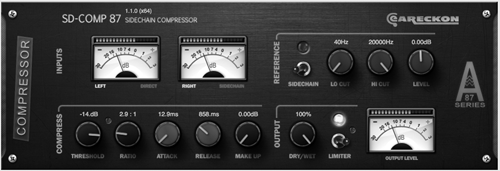
If the SD-COMP 87 has a “sound’ it can be said to be somewhat 1176-ish (as opposed to a softer, slower LA-2A character). Given its wicked-fast attack time and slightly aggressive character, this compressor definitely comes off sounding opto rather than tube. But these have more to do with the response, rather than the static character, of which there is little. It’s lots of very clean-sounding compression, although it will gladly produce pumping if you push it. The sidechain function is an added bonus, as is the built-in limiter and the Mix function.
OPEN THE GATE
While we’re in the land of dynamics, it’s worthwhile to look at the SD-GATE 87, which performs either gating or ducking depending upon the setting of the toggle switch in the lower left. It is equipped with a sidechain input, as well as two adjustable thresholds that define the amplitude areas that will be effected. These can be linked such that they change together, or unlinked which allows setting them independently.
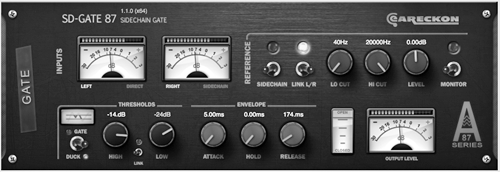
When the SD-GATE 87 is switched to Gate mode, then sounds whose amplitude drops below the lower threshold cause the Gate’s output to be muted, until the point at which the sound’s amplitude exceeds the upper threshold. When switched to Duck mode, the opposite happens when the two thresholds are linked; sounds are allowed to pass while below the upper threshold. When they exceed the upper, the gate closes until the level drops below the lower threshold. Unlinking the thresholds creates some interesting effects when in Duck mode.
Incidentally, having two separate thresholds on an audio gate is not unique on either hardware or software implementations of gating, but it is unusual especially on a plug-in at SD-GATE 87’s price point. When a signal crosses the threshold regularly, it can cause a gate to “chatter” as it turns on and off quickly. Having a second threshold introduces hysteresis and smoothes out the gate’s performance. It’s a nice touch.
The envelope controls, consisting of Attack, Hold, and Release, are properly calibrated and have sufficient range to make them useful. Using a mouse to adjust them can be a bit fiddly; fortunately you can type in a specific value on any control. The sidechain section comes with filters and gain, and the whole business looks and feels right. After using the bare-bones gate plugs included with most editors, the SD-GATE 87 looks like the bridge of the Enterprise. There are more than enough parameters available to get what you want, and have a good-sounding result. After all, all you want is to turn some soft stuff down, right?
MAXIMIZING LIMITS
The BW-LIMIT 87 is a dedicated brickwall limiter which will also process your sound to “maximize” it. Again, eaReckon provides some nice surprises in what is usually a simple processor. The best of these is under a switch labeled Maximize which, when engaged, automatically adjusts the gain of the limiter to raise the volume of the loudest peaks up to the level set by the Output Level knob, while still preventing those peaks from exceeding the Level setting.
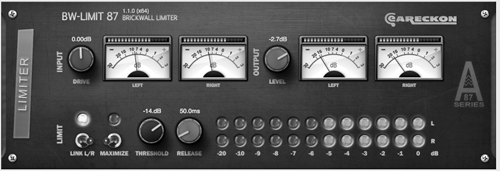
The unit is a full stereo processor, but there’s a Link L/R switch which allows channels to be processed separately but with the same settings. And if that confused you don’t feel bad; it did me as well. It decouples the two processors such that they will limit each channel separately, which of course will totally screw up any sort of phase coherency across the stereo bus. Maybe it’s one of those functions that exists just because they can make it exist. On the other hand, the meters are big and hard to miss in use, a bonus compared to others I’ve used.
Also notable is that although there’s a Release setting for the Limiting, there is no Attack knob. eaReckon decided that because BW-LIMIT 87 is a brickwall limiter, they would forego the Attack knob in favor of a preset Attack time that includes look-ahead to optimize the “wall” portion of the brickwall for maximum rise time without distortion.
A good limiter is a tool I use on almost every session, including printing the limiter on a voiceover tracks when the talent is dynamic (think video games). The BW-LIMIT 87 is a winner.
PARAMETRICALLY YOURS
The PR-EQUA 87 is a four-band fully parametric equalizer with both high- and low-cut filters with either a 12 or a 24 dB/octave slope. The low and high parametrics are dual shelving, while the low-mid and high-mid are bell-curved. All four parametrics feature plus and minus 24 dB of gain, topped off by a built-in limiter that caps the output level at 0 dB. The bonus here is a built-in RTA (Real Time Analyzer) that provides a visual representation of the frequency content of the output.
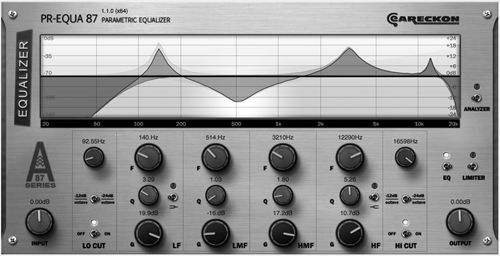
eaReckon decided to design the parametrics with fixed ranges, rather than make each full-range, which is fine with me -- I find that arrangement more natural anyway, as it harkens back to the days when I used an analog console (wait, I did a job with an analog board last month! Never mind).
The EQ here is very clean, with almost no coloration of its own. With a maximum Q of 10, it’s not as surgical as some of the EQ plug-ins out there, but that is more than enough to handle sound shaping and general audio cleanup work. The PR-EQUA 87 is more CPU-intensive than the other plugs in the collection, but even with that on playback one instance maxed out in Reaper at .35% CPU use in the worst instance, so eight will cost you about two-point-something percent or thereabouts with all the filters in use on a Core 2 Duo. Not bad for a good-sounding, uncolored four bank parametric. While it is not labeled as phase linear (a design which is way more CPU-costly), the PR-EQUA 87 behaved well with stereo audio files from a phase standpoint, and is ideal for tracking.
MASTER CHANNEL CONTROL
This is the best of the bunch, IMHO. CS-STRIP 87 takes the core functionality of all of the other plugs and houses them under one roof. You won’t find sidechaining here, but the best of the others made it in.
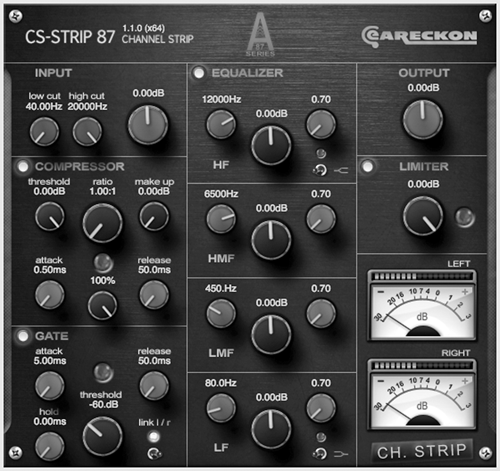
The Input section has fixed 40 Hz low cut and 20 kHz high cut. The Compressor has the same Ratios, Attack time, and Release times as does the SD-COMP 87, and the Mix knob for parallel processing is there as well. The Gate is similarly configured, and includes the L/R link switch. The Equalizer section has the four-bands of parametric (but not the cut filters, and of course there is a limiter.
All of this is remarkably thrifty with CPU cycles. One instance weighs in somewhere in the .5% range most of the time. That’s thrifty, lad, and the sound is as bonnie as its cousin plugs.
LIKE AND NOT LIKE
The standouts in this collection for me are the CS-STRIP 87 and the BW-LIMIT 87, although there’s not a dud in the package. All these plugs are CPU-friendly and sound good. They do their job without imparting much in the way of color, and for most jobs that’s just fine... nice and clean. About the only complaints I have regard the copy protection, and I understand that it’s a necessary evil for a small company. The PDF manual is clear regarding basic operation, but I would like to see it expanded in terms of the technology. For example, does the SD-COMP 87 model a forward-feed compressor? Does the response model an opto circuit? These aren’t deal busters, but are of interest to tech heads like me.
All these plugs are available as a 30-day demo with some limitations. What’s better is that there are FREE versions of the compressor, EQ, limiter, and gate which are limited in features but not in sound. If you do nothing else, head over to www.eaReckon.com and get those while they’re hot. I suspect you’ll end up with the whole collection. Steve sez check ‘em out.
The ANALOG87 series carries a suggested retail of 99 € (that’s about $137.50 in USD at this writing, not bad for five plugs), or they can be had individually for 39 € for the CS-STRIP 87 and 29 € each for the others. For more information worldwide, visit www.eaReckon.com.
♦

